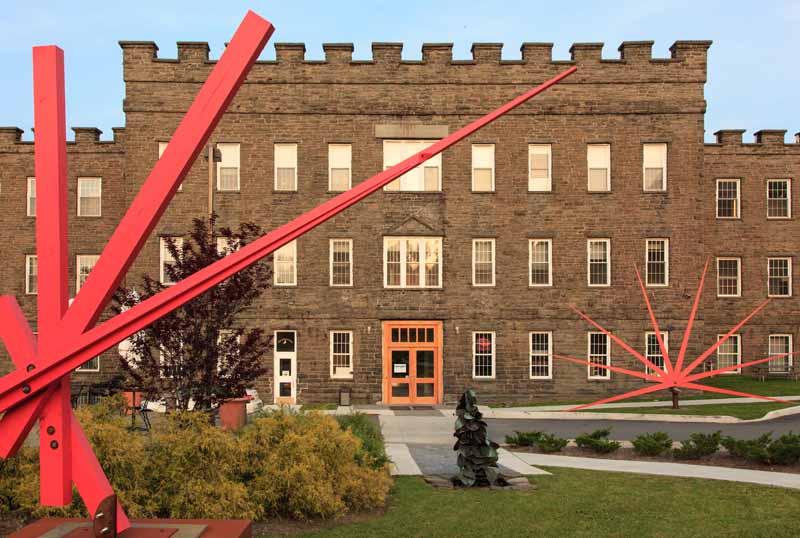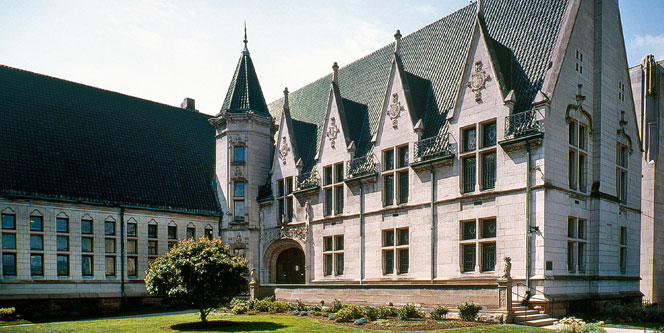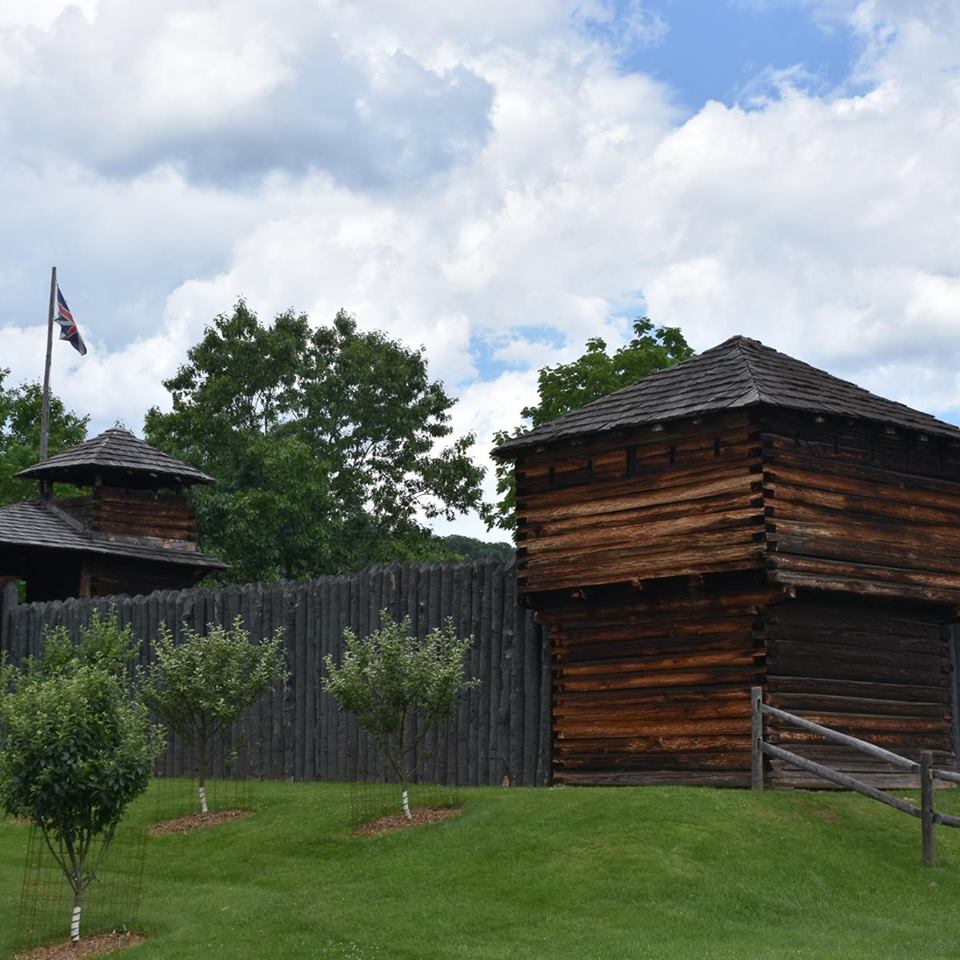When you think of castles, places such as Ireland, England and France probably come to mind. In America, the iconic structures are few and far between. But, the little town of Hawley in the northern Pocono Mountains boasts its own castle. The hulking 75,000 square foot Hawley Silk Mill was built in 1880. It’s the largest Bluestone structure in the world and listed on the National Register of Historic Places.
If you covet castles and can’t get enough of the decidedly regal architecture, we’ve put together a guide to some of the fancy fortifications you can find here in Northeastern Pennsylvania and the Pocono Mountains. Take a tour to see these fascinating fortresses. Most have been repurposed and are open to the public, but all make for an impressive photo op.
1. Hawley Silk Mill
We hate to play favorites, but we think we have the best example right here in Hawley! The Hawley Silk Mill is a landmark located along Route 6 in the lake region of the Pocono Mountains. Laid entirely from Bluestone, the castle-like exterior comes complete with parapets! It was originally built in 1880 as the Bellemonte Silk Mill and masonry on the exterior still bears the name. At the time of its construction, the building cost an estimated $130,000. Its design is shaped like a Greek cross and measures 364 feet by 44 feet with a 20-foot central extension that’s 80 feet high at its northern end. The open floor plan was supported by massive steel beams, which still exist today as does the original maple hardwood flooring. Ownership changed hands several times, but the building remained a textile factory until 1990. It served a brief stint as an antique store before it was purchased and repurposed as a lifestyle center. Today, the three-story structure is still a vibrant part of the community with retail shops, an art gallery and a fitness center occupying the first floor. Professional offices reside on the second floor and a satellite campus of Lackawanna College is located on the top level. A commercial bakery and unique event space called The Boiler Room are located in the lower level. There’s also a deck accessible from the rear of the building that overlooks Paupack High Falls.

Outside, a smaller stone building that once housed the mill’s silk and cocoons, was reimagined into a quaint coffee house and bakery. The menu features craft brewed coffee, smoothies, gourmet pastries and treats, creative sandwiches and more. Cocoon Coffee House and Bakery is open for breakfast and lunch and also carries locally sourced cooking essentials such as eggs, cheese, meats, jams and oils. History buffs, architecture lovers, shoppers and everyone in between will appreciate a visit to Hawley Silk Mill.
2. Old Jail Museum
Opened in 1870 as the Carbon County Jail, this imposing two-story building is built of stone. Notable architectural features include a one-story guard turret and arched windows throughout. The stone fortress presides over West Broadway in downtown Jim Thorpe. It served as the county jail until 1980 and is infamous for confining and executing seven Irish coal miners known as The Molly Maguires in 1877. Visitors can tour the Old Jail Museum to see the 27 cells and basement dungeon used as solitary confinement.
3. Albright Memorial Library
The headquarters for Lackawanna County’s public library system would be at home in medieval times. In fact, the library, which opened in 1893, was built to resemble the 15th century Musee de Cluny in Paris. Former Scranton resident and coal shipping magnate, John Joseph Albright was the library’s benefactor. He donated the sum of $125,000 for its construction and hired Buffalo, NY architect Edward B. Green for the design. The French Renaissance style structure is made of Indiana Limestone and Medina Sandstone and boasts a steep roof of black tile, decorative dormers and stained-glass windows. Today, visitors to the library can still see intricately carved woodwork, high vaulted ceilings and opulent marble fireplaces. Noted landscape architect Frederick Law Olmstead was responsible for the property’s exterior design, but much of it was lost over time. The Albright Memorial Library is located on Vine Street in downtown Scranton and is listed on the National Register of Historic Places.

4. Scranton Cultural Center
Listed on the National Register of Historic Places, this downtown Scranton landmark has an impressive pedigree. Architect Raymond Hood, noted as the designer of Radio City Music Hall and Rockefeller Center, was the person in charge of its construction. The Scranton Cultural Center was completed in 1930 and is an excellent example of Art Deco and Gothic styles. An imposing exterior of Indiana limestone belies an interior full of intricate woodwork and colorful plaster moldings.
5. Bradford County Historical Society
Another former jail built in a style reminiscent of a castle. Today the Bradford County Jail serves as headquarters for the Bradford County Historical Society. The historical society also operates a museum out of the building on Pine Street in Towanda. The massive three-story structure was built in 1871 with stone quarried from nearby Barclay Mountain. The imposing design features a dwelling house in front with cell blocks behind. A guard turret with parapets stands in the middle. The building served as a prison for men and women from 1871 to 1991. Visitors may tour the museum and see exhibits creatively arranged on two floors in former cell blocks. The third floor houses a genealogical and historical research library.

6. Grey Towers National Historic Site
Two-time Pennsylvania Governor Gifford Pinchot lived in this French Chateau style castle in Milford, PA until his death in 1943. Gifford’s father, James, had the mansion built in 1885 at a cost of $19,000 to serve as the family’s summer retreat. He commissioned famed architect Richard Morris Hunt to design the 42-room residence in a style that reflected the Pinchot’s French ancestry. Built primarily of fieldstone, two large turrets give the mansion its distinctive look. In 1963, the Pinchot family donated the 102-acre property to the U.S. Forest Service since Gifford served as the agency’s first chief. Visitors to Grey Towers National Historic Site may tour the home’s first floor to see the grand entry hall, living room, dining room and library. There are several noteworthy structures in the garden to see as well including the Finger Bowl- a custom designed dining table, which consists of a raised pool surrounded by flat stones. Food was served from bowls floating in the water. Other points of interest in the garden include The Bait Box, built as a playhouse, and The Letter Box which served as Gifford’s archive.
7. Watres Armory
It seems fitting that this Medieval-looking castle in Scranton, PA was once home to Pennsylvania’s National Guard 109th Infantry Regiment. Watres Armory was built in 1900 of brick and mortar in the Romanesque Revival style. The most notable exterior features of the four-story structure are its massive stone arch entrance flanked by crenellated towers on either side. Visitors to the site include five U.S. Presidents, including Theodore Roosevelt and John F. Kennedy. In 1989, the building was added to the National Register of Historic Places. In 2011, the National Guard relocated to a more modern facility. The structure sat vacant for a few years until it was purchased by artist Hunt Slonem. The artist, whose Neo-Expressionist paintings hang in The Metropolitan Museum of Art, Guggenheim and the Whitney, acquired the 102,000 square foot building to house his massive collection. Slonem renovated the place to use as a private museum to store not only his own paintings, but also his collection of antique furnishings and sculptures. Although the building is not open to the public, a new book, “Gatekeeper: World of Folly,” captures the scenes inside.
8. Lackawanna County Courthouse
The physical home of Lackawanna County’s seat was built from 1881-1884 and remodeled in 1896. Victorian Gothic and Romanesque details give the courthouse its castle-like appearance. Locally quarried stone from West Mountain was used along with Onondonga Limestone. Unique architectural features include a five-story clock tower, tall corner towers, carved stone details, ornamental buttresses, round arched-windows and tower openings. The Lackawanna County Courthouse is featured during Guided Downtown Walking Tours offered by the Lackawanna Historical Society on select Saturdays throughout Summer.
9. Marie Antoinette Overlook
It’s not a castle, but it has some cool castle-like qualities. The scenic spot along Route 6 in Bradford County was built in 1930 by the Works Progress Administration. The vantage point offers a spectacular view of the North Branch of the Susquehanna River and French Azilum Historic Site 500 feet below. A covered fieldstone turret serves as the observation area.
10. Fort Delaware Museum
Ok, it’s not a castle, but Fort Delaware deserves an honorable mention. The heritage site is an authentic re-creation of the first colonial settlement on the Upper Delaware River in 1754. High log walls, called stockades, surround stout log homes offering protection from enemies and the elements. Visitors may stroll the grounds in Narrowsburg, NY and tour the blockhouse, where ammunition was stored, settlers’ cabins, a spinning, weaving and barn loom area, blacksmith shop, candle-making shed and more. Costumed interpreters in period dress demonstrate 18th century life skills, including: cooking, animal care, dipping candles and the firing of a half- pound British swivel cannon. Fort Delaware Museum is open weekends Memorial Day through Labor Day.

While you’re castle hopping you can be treated like royalty with a stay at one of Settlers Hospitality’s distinctive properties. There are five accommodations throughout the Pocono Mountains, Lackawanna County and Bethlehem. Each offers superior service, luxurious guestrooms and first-class amenities.
